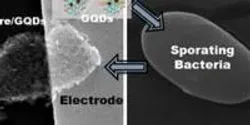graphene

Graphene, a strong, lightweight carbon honeycombed structure that’s only one atom thick, holds great promise for energy research and development. Recently scientists with the Fluid Interface Reactions, Structures, and Transport (FIRST) Energy Frontier Research Center (EFRC), led by the US Department of Energy’s Oak Ridge National Laboratory, revealed graphene can serve as a proton-selective permeable membrane, providing a new basis for streamlined and more efficient energy technologies such as improved fuel cells.

X-ray photoelectron spectroscopy (XPS) is one of the most sensitive and informative surface analysis techniques available. However, XPS requires a high vacuum to operate, which makes analyzing materials in liquid and gaseous environments difficult.

In subway stations around London, the warning to “Mind the Gap” helps commuters keep from stepping into empty space as they leave the train. When it comes to engineering single-layer atomic structures, minding the gap will help researchers create artificial electronic materials one atomic layer at a time.

University of Illinois at Chicago researchers have discovered a way to create a highly sensitive chemical sensor based on the crystalline flaws in graphene sheets. The imperfections have unique electronic properties that the researchers were able to exploit to increase sensitivity to absorbed gas molecules by 300 times.














